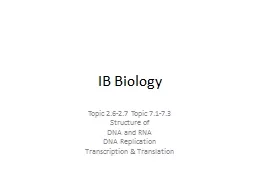

Structure of DNA and RNA DNA Replication Transcription amp Translation Nucleotides 3 major nucleic acids DNA RNA ATP DNA amp RNA Made of nucleotides monomer Nucleotides One phosphate ID: 932058
Download Presentation The PPT/PDF document "IB Biology Topic 2.6-2.7 Topic 7.1-7.3" is the property of its rightful owner. Permission is granted to download and print the materials on this web site for personal, non-commercial use only, and to display it on your personal computer provided you do not modify the materials and that you retain all copyright notices contained in the materials. By downloading content from our website, you accept the terms of this agreement.
Slide1
IB Biology
Topic 2.6-2.7 Topic 7.1-7.3
Structure of
DNA and RNA
DNA Replication
Transcription & Translation
Slide2Nucleotides
3 major nucleic acids:
DNA, RNA, ATP
DNA & RNAMade of nucleotides (monomer)Nucleotides:One phosphateOne 5 carbon monosaccharideOne nitrogenous base
Slide3Bases:
Adenine
Guanine
CytosineThymineUracil in place of thymine in RNAPurines and Pyrimidines:
Slide4Monomers
Polymers
Backbone:
Alternating pentose-phosphate Bases extend outward Order of bases determine genetic code for organismCovalent bonding between components
Slide5Single or Double Strand
RNA- always SS
A-U, G-C
DNA always DSBases are paired: complementary base-pairingA-T, G-CHydrogen bonds between bases
Slide6Anti-Parallel Arrangement
Deoxyribose + phosphate= phosphodiester bond (linkage)
Forms between hydroxyl group of 3’ carbon of deoxyribose and phosphate group to 5’ carbon of deoxyribose
New always added to 3’ carbon endResult: Double strand has 2 directions
Slide7DNA Packaging
Paired with histone proteins for organization
Nucleosome-
2 molecules of each of 4 different histones (8 histones total)DNA- (-) charge and histones (+) chargeBetween nucleosomes, often a 5th histone attached to linking string of DNAAdditional histone
supercoiling
Slide8DNA Packaging, cont.
Supercoiling of DNA makes it inaccessible to transcription enzymes
Form of regulation
Only certain areas of DNA involved in protein synthesis
Slide9Types of DNA Sequences
Highly Repetitive sequences:
5-300 base pairs
100,000 replicates of a certain type per genomeClustered in discreet areas- satellite DNADispersed throughout-Coding function not known
Slide10Types of DNA Sequences, cont.
Protein Coding Genes
Provide base sequences
proteins via ribosomesBase sequences carried from the nucleus to the ribosomes via mRNAGenes not fixed sequence of bases, but coding info (exons) mixed with non-coding fragments (introns)
Slide11Types of DNA Sequences, cont.
Structural DNA:
Highly coiled- has no coding function
Around centromere and near ends of chromosomesPseudogenes: lost coding function due to mutation involved with a base change
Slide12Types of DNA Sequences, Cont.
Short tandem repeats and DNA Profiling:
Most of our DNA is identical to every other human
Specific regions that show variation: polymorphismsPolymorphisms are used for DNA profilingLook at 13 specific loci: short tandem repeats (STRs) of 2-5 base pairs
Slide13Semi- C
onservative
R
eplicationWatson and CrickStructure of DNASingle strand of DNA used as templateMeselson and StahlConfirmed findingsBacterial DNA replication process developed as result
Bacterial DNA:
Circular
No histone proteins
Single point of origin for replication of DNA
Eukaryotic DNA:
Linear
Has histones
Has thousands of points of origin
Slide14Semi-Conservative Replication, cont.
Replication steps:
1. Begins at origin, appears as a “bubble”
2. Helicase unzips H bonds between bases.3. End of bubble replication fork4. Bubbles enlarge in both directions and eventually fuse to produce 2 identical daughter strands
https://
www.youtube.com/watch?v=dKubyIRiN84
Slide15DNA Replication
Elongation of DNA strand
1. Primer produced by
primase at replication forkPrimer is 5-10 nucleotides of RNAPrimase allows joining RNA nucleotides that match DNA sequence
2.
DNA polymerase III
allows the addition of nucleotides in a 5’ to 3’ direction
3.
DNA polymerase I
removes primer from 5’ end and replaces it with DNA nucleotides
4.
Topoisomerase (DNA gyrase)
stabilizes
DNA above helicase
Slide16DNA Replication, cont.
Anti-Parallel
strands
One 5’ 3’, one 3’ 5’DNA only assembled in 5’ 3’ direction due to DNA pol III.3’ 5’ template strand made quickly and continuously-
leading strand
5’ and 3’ template strand made discontinuously and in pieces-
lagging strand
Pieces are called
Okazaki fragments
Fragments are joined by
DNA ligase
Slide17DNA Replication, cont.
1.
Leading strand
assembled continuously2. Lagging strand assembled in Okazaki fragments3. Primer, primase, and DNA pol III
required to begin formation of each
O
kazaki fragment
4.
Primer and primase
needed only once for leading strand
5.
DNA ligase
attaches sugar-phosphate backbone together
Slide18Replication Proteins
Replication in prokaryotes and eukaryotes is almost identical
Slide19Speed and Accuracy of Replication
4000 nucleotides per second
Bacteria-
Speed essential, divide every 20 minutesRemarkably accurate-Few errors occurCells have repair enzymes that detect errorsRepair enzymes also used when cells are damaged by chemicals or high energy waves
Slide20Replication, DNA Sequencing, Human
G
enome
ProjectHGP required actual representation of nucleotide sequence in humans.Sequencing DNA-1970s Sanger developed sequencing procedureFragments of DNA copied through PCR (polymerase chain reaction)
Read and outline section on
page 332-333
bring
questions to class.